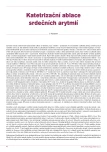Catheter ablations of cardiac arrhytmias in Czech republic: contemporary state
Authors:
R. Čihák
Authors‘ workplace:
Klinika kardiologie IKEM, Praha
Published in:
Kardiol Rev Int Med 2006, 8(Supplementum): 6-9
Overview
In the Czech Republic, the catheter ablations of arrhythmia have been made since 1983, with the use of radiofrequency energy since 1992. Since 1997 the operations are filed in the ablation registry. In 2005, totally 13 centres for adult and 2 centres for child patients made ablations. There have been made totally 2,770 ablations this year, almost 2/3 of them were made for atrial flutter and for atrioventricular (AV) nodal re-entry tachycardia. The number of ablations for atrial fibrillation is increasing; the operations are made for almost all arrhythmia types. In connection with it, the new technologies are used more frequently, especially the ablation and map catheters, ablation energies, 3D mapping methods and also imaging methods.
Keywords:
catheter ablation of arrhythmia – radiofrequency energy – ablation registry – mapping methods – imaging methods
Sources
1. Scheinman MM, Morady F, Hess DS, Gonzalez R. Catheter–induced ablation of the atrioventricular junction to control refractory supraventricular arrhythmias. JAMA 1982; 248: 851–5.
2. Budde T, Breithardt G, Borggrefe M et al. Initial experiences with high–frequency electric ablation of the AV conduction system in the human. Z Kardiol 1987; 76: 204–10.
3. Kautzner J, Čihák R, Bytešník J. Pokroky v elektrofyziologii: katetrizační ablace srdečních arytmií a implantabilní kardiovertery–defibrilátory. Cor Vasa 2001; 43: 225–231.
Labels
Paediatric cardiology Internal medicine Cardiac surgery CardiologyArticle was published in
Cardiology Review

2006 Issue Supplementum
Most read in this issue
- Catheter ablation of atrioventricular nodal reentrant tachycardia: therapy of the first choise?
- Catheter-based treatment of common atrial flutter yesterday and today
- Catheter ablation of accessory links: solved question?
- AV node ablation: new aspects in the time of curative therapy of atrial fibrillation and cardiac resynchronization therapy
